B. Bamathy1, K. Punnagai2, C. A. Amritha3 and D. Darling Chellathai4
1Department of Emergency Medicine, Sundaram Medical foundation, Chennai, India.
2Department of Pharmacology, Sri Ramachandra Medical College and Research Institute, Chennai, India.
3Department of Pharmacology, Tagore Medical College, Chennai, India.
4Department of Pharmacology, SRMC and RI, Chennai, India.
Corresponding Author E-mail: punnagaiguna@hotmail.com
DOI : https://dx.doi.org/10.13005/bpj/1231
Abstract
Acute poisoning is a medical emergency. It is important to know the incidence, patterns and outcome of acute poisoning cases in order to take up appropriate planning in prevention, safety measures and management. This study aimed to assess the incidence and patterns of poisoning and drugs used in the management of poisoning in a tertiary care hospital located in Chennai catering to urban & semi urban population. This was a retrospective observational study. Data was collected from the medical records of the emergency department of the hospital. The study included 218 cases and data regarding age, sex, Mental health history, Name/type of poisoning agent, Drugs administered, Duration of hospital stay, Outcome of the treatment were collected in a prestructured proforma. Among the total 218 patients, males were 113 (51%) and females were 105 (49%). Patients consumed Organophosphorous poisoning were 64 (29%), Tablet overdose were 74 (34%) and rest like mosquito repellant, rat killer poison, kerosene, acid etc., were 80 (37%). Intention of these poisoning episodes was suicidal in 198 (91%) patients and accidental in 20 (9%) patients. Among 0-18 yrs age group of patients those who reported Organophosphorous compound poisoning was 1, tablet overdose was 2 and the rest (mosquito repellent, kerosene, rat killer) were 6 especially in children. In the age group of 19-30, the patients with OPC were 31, tablet overdose was 33 and remaining (mosquito repellent, rat poison and acid) were 32 patients. After intervention and management 203 (93%) patients recovered and 15 (7%) patients died. The common drugs used apart from first aid measures were Atropine, Oximes, Vitamin K, and Flumazenil. Other adjuvant drugs used are Ondansetron, Pantoprazole, Antibiotics, Antiepileptics and Antacids. The female patients tend to consume tablets and mosquito repellent poison more than the OPC poisoning. From this study, we analyzed the incidence and patterns of acute poisoning in patients reporting to emergency medicine department. The incidence of Tablet poisoning is highest followed by Organophosphorous compound poisoning in our study. In our study we found the incidence of mosquito repellent poison consumption has increased considerably. The drugs most commonly used were Flumazenil and Atropine. The easy availability of the pesticides and the over the counter prescription drugs might be one of the major reasons for the increased incidence of poisoning among urban and semi rural general population especially among younger adults.
Keywords
acute poisoning; Incidence and Patterns; tablet overdose; Organophosphorous compounds
Download this article as:| Copy the following to cite this article: Bamathy B, Punnagai K, Amritha C. A, Chellathai D. D. Incidence and Patterns of Acute Poisoning Cases in an Emergency Department of A Tertiary Care Hospital in Chennai. Biomed Pharmacol J 2017;10(3). |
| Copy the following to cite this URL: Bamathy B, Punnagai K, Amritha C. A, Chellathai D. D. Incidence and Patterns of Acute Poisoning Cases in an Emergency Department of A Tertiary Care Hospital in Chennai. Biomed Pharmacol J 2017;10(3). Available from: http://biomedpharmajournal.org/?p=16494 |
Introduction
Acute Poisoning due to pesticides and drugs are one of the important causes of morbidity and mortality throughout the world. According to a study published in lancet in 2012, suicide is an important cause of avoidable deaths, in India especially in young adults, poisoning is considered as the major cause of deaths due to suicides.1 Alcoholism, Violence on women, Easy availability of insecticides over the counter, Psychiatric disorders among the population, lack of awareness of the identification and management of poisoning and intensive and community health care facilities in the remote areas of the country are the top leading causes of poisoning deaths which are easily preventable and treatable.2,3 One more important finding in a study is higher education and residency in southern India was associated with an increased risk of suicide among students and young adults.4 We assume residency in South Indian cities like Chennai where the expectations run high among the common general public for academic achievements on the young student population as well as work related goals and achievements in adults may precipitate stress and generalized anxiety leading to psychological problems. This might result in high incidence of poisoning due to suicidal tendencies. This study was conducted at the tertiary care centre which is in rapidly growing urban area where there is considerable size of patient population reporting to emergency department with acute poisoning consumption. There are not many studies in the incidence and patterns of the acute poisoning in Chennai focusing on the urban and semi urban population. With this background, this study was designed to find out the incidence and patterns of poisoning (accidental & intentional) and drugs utilized in the management of poisoning cases in a tertiary care hospital located in Chennai catering to urban and semi urban population. In this study we plan to analyze the age, sex, type of poison, duration of stay in the hospital, drugs used in the management and outcome of the poisoning episodes. This study aimed to assess the incidence and patterns of poisoning and drugs used in the management of poisoning in a tertiary care hospital located in Chennai catering to urban & semi urban population.
Materials and Methods
Type of Study
It is a retrospective study of data collected from medical case records of SRMC & RI, a tertiary care hospital. All the case records of poisoning patients of both sex and age (from 6 months to 85 years) admitted in the emergency ward from April to June 2014 were included in the study. Snake bites, scorpion sting and food poisoning were excluded from the study. Study period was 3 months.
Data collection
The study was conducted after obtaining proper permission from respective authorities (Dean, Medical superintendent, Head of the department of Emergency Medicine and Ethics committee). The Principal investigator collected the case records from the Medical Records Department of Sri Ramachandra University. Data was collected from the case records using a structured format (case proforma). The key information included in the structured format are age, sex, marital status of the patient, Mental health history, Family history, Name/type of poisoning agent, Management in the ward and ICU and drugs administered, Ventilator support, Duration of hospital stay, Outcome of the treatment. These case proforma data were finally analyzed with the help of a statistician using descriptive statistics.
Results
Results were analyzed from the medical records under the following headings: (a) Incidence of Poisoning Agents, (b) Types of Poisons, (c) Demography like age, gender, residence, mental status of the poisoning patients, (d) Duration of stay in the hospital after acute poisoning episode (e) Age wise incidence of the type of poisoning (f) The reason for the intake of poison (g) Drugs used for management of poisonings (h) outcome of the poisoning episode
Table 1 shows a total number of 218 case sheets of patients admitted for poisoning in the emergency department during April to June 2014 were analyzed. Males were 113 (51%) and females were 105 (49%). As shown in Figure 4 there was female predominance in tablet overdose and males outnumbered females in organophosphate pesticide poisoning.
Table 1: Sex ratio of the poisoning cases.
| Total no. of patients – 218 | % | |
| Males | 113 | 51 |
| Females | 105 | 48 |
Figure 2 shows type of poisoning agents that out of these 218 patients those who consumed Organophosphorous poisoning (OPC) were 64 (29%), Tablet overdose were 74 (34%) and rest like mosquito repellent, rat killer poison, kerosene, acid etc., were 80 (37%). As in Table 3, the length of hospital stay (duration of treatment in hospital) is also varied between groups. In OPC group it was maximum upto 8 days and tablet overdose was 2 days. 71% of the patients were discharged after recovery in 3-4 days, and less than 3 days were 86 patients, in 5-9 days around 46 patients and in 1-19 days duration were 13 patients.
Table 2: Survival rate of the poisoning cases.
| Deaths | 15 | 7% |
| Recovered | 203 | 93% |
Table 3: Length of hospitalization in days (longer stay for ventilator support).
| OPC | TAB | OTHERS |
| 8 | 2 | 0 |
The age group of patients who consumed a particular type of poison were also analyzed and in Figure 5 its shown among 0-18 yrs group of patients who reported Organophosphorous compound poisoning was 1, tablet overdose was 2 and rest like (mosquito repellent, kerosene, rat killer) was 6 especially children. In the age group of 19-30, the patients with OPC were 31, tablet overdose was 33 and remaining (mosquito repellent, rat poison and acid) was 32 patients.
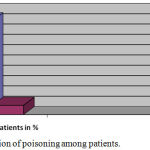 |
Figure 1: Intention of poisoning among patients.
|
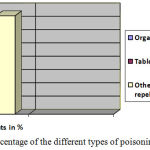 |
Figure 2: Percentage of the different types of poisoning cases.
|
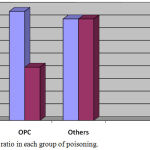 |
Figure 3: Sex ratio in each group of poisoning.
|
As shown in Fig 1, Intention of these poisoning episodes were majority suicidal in 198 (91%) patients and accidental in 20 (9%) patients. After intervention and management 203 (93%) patients recovered and 15 (7%) patients died. In the patients who took OPC poisoning, there were 43 males and 21 females and in the other type of poison consumption, there were 40 patients with equal distribution among both sexes.
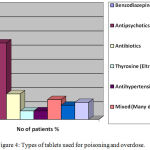 |
Figure 4: Types of tablets used for poisoning and overdose.
|
Figure 5 shows in the tablet overdose group, most of the drugs commonly consumed for suicidal intention were Benzodiazepines (39%), Atypical antipsychotics (27%), Antihypertensives (2%), Antibiotics (7%), Thyroxine (2%), Antihistamines (4%), Multiple drugs (>5%) and rarely Digoxin, Metformin, Carbamazepine, Salbutamol and Ranitidine (1% each).
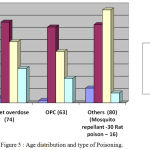 |
Figure 5: Age distribution and type of Poisoning.
|
The most commonly utilized drugs for the treatment were general measures followed by Atropine, ondansetron, proton pump inhibitors, antacids and Flumazenil to a lesser extent.
Discussion
In our study, which aimed to find out the incidence and patterns of the acute poisoning cases in a tertiary care hospital in urban Chennai, we collected 218 case sheets of patients reported to the emergency department of a tertiary care hospital in the study period of 3 months. The sex ratio of patients who consumed poison was almost equal (1:1.04). The most common type of poisoning consumed by the patients was drug(tablet) overdose (34%) followed by organophosphorous poisoning (29%) and then rest of the agents (mosquito repellant, rat killer etc.,) were 37%. Most of the patients belonged mostly to semi urban and urban category. The drugs which were misused for the purpose of poisoning were sedatives (39%) especially Alprazolam and Diazepam and antipsychotics (27%) followed by antibiotics and Antihypertensives across all cross sections of age. Results of our study showed tablet overdose as a major reason for acute poisoning correlated with the findings of a study done by Das RK in AIIMS5; whereas in many studies done on poisoning in adolescent age group in Japan and Taiwan, street drugs and over the counter medicines like paracetamol, antihistamines were commonly consumed for intentional poisoning.11,12 The easy availability of these drugs without prescription and over the counter in the pharmacies might be the cause for the poisoning in these patients. In a study done by M.G. Rajanandh and S.Santhosh, reported that one of the most common causes of poisoning in Tamilnadu also include drug overdose next to pesticide and alcohol poisoning, which they attributed to over the counter availability of risky drugs like antipsychotics which correlated with our study.6
It was observed in the study, females and young adults used mosquito repellants containing Prallethrin, a Type 1 pyrethroid compound. (Brand names are All out & good night) as poisoning agents as they are easily available. Pyrethroids are roughly 2250 times more toxic to insects than humans. Their toxic effects are due to delayed closure of the voltage gated sodium channels and in higher doses act on the GABA chloride channels inducing seizures.7 According to a study conducted by Vivekanandhan et al, in a tertiary care hospital in Kanchipuram where the most common poison consumed was organophosphorous compounds as the majority of the patients were involved in agriculture.8 In our study Organophosphorous compounds are the second single most common poisons consumed by the patients. Some of the pesticide poisoning patients had been referred from rural primary health centres after emergency management. The severity as shown by the need for intensive care admission with ventilator support, duration of stay in the hospital and the death rate was more in the group of patients with OPC poisoning. Patients with OPC poisoning who were on ventilator support stayed for longer time. Most of the patients who had tablet overdose spent less duration of stay in the hospital. A study by Basu et al has revealed that there is rapid upsurge in patients consuming Organophosphorous pesticide in a period of 3 years.9 In a study done by Deepak Pokhrel et al. in Kathmandu, the most common agent used for poisoning is Organophosphorous compounds followed by phosphides in married people.10 Organophosphate pesticides (OPC) are easily available and often stored in an improper manner due to lack of facilities and awareness of their hazards among rural people. Our study also reports more deaths for OPC poisoning. After exposure to OPC the occurrence of toxicity is due to the amount of poison, onset of effects take 30mts to 2hrs. The interval between the exposure and the therapy affects the morbidity and the mortality.14,15 In our study as shown in Table 2 the death rate analyzed from the sample size of case sheets was 7% of which six patients had consumed OPC and 1 death was due to mixed tablets of Antihypertensives. The mosquito repellants and rat killer poison were consumed by almost all the age groups more in the age group of 31-50. Most of the poisoning was intentional (91%) to commit suicide due to various reasons like family problems, psychiatric disorders, mood disorders, work pressure and coping problems in the hostel amongst youngsters.13 Since we included the urban hospital as the study centre, the pattern of poisoning was observed to be drug (tablet) overdose than rural areas where it was observed to be organophosphorous compound poisoning.16,17 These results make us to narrow down on the easy availability of the poison or a medication to a suicidal person is found to be one of the major factors for the increased incidence and specific pattern of poisoning cases.
The drugs utilized for the management of poisoning are for OPC poisoning, apart from stomach wash, lavage, activated charcoal and first aid measures, are Atropine, Oximes were used. In other poisons, Vitamin K for rat killer poison, Flumazenil for benzodiazepine overdose, N-acetylcysteine for paracetamol poisoning were used. For supportive management antibiotics, ondansetron, antacids, diuretics, antiepileptics and proton pump inhibitors were also used. Psychiatric counseling and therapy were given to most of the patients. Most of the patients revealed during counseling that they face family and work related problems leading to impulsive suicidal behaviour. Easy availability & impulsive control behaviour in the patients are the most dangerous combination to cause injury and death. Creating awareness among the general population regarding medication overdose, pesticides with the implementation of strict medication safety monitoring and policies is recommended. The preventive measures like to restriction of over the counter sale of drugs especially sedatives, antipsychotics, antidepressants and cardiovascular drugs are the need of the hour. Reducing the pill package size and safe storage of drugs in household and properly sealed mosquito repellants will prevent suicides due to poisonings and drug overdose. Identification of potential symptoms of depression, impulsive control disorders and anxiety in people would definitely reduce the suicidal tendencies in the people and decrease the mortality and morbidity due to intentional poisoning. |Setting up of toxicology units, help lines, counseling in hospitals and centres to prevent many deaths due to poisoning and suicides. The limitations of the study are retrospective in nature, small sample size. In our study we found that the majority of the patients who attended belonged to young to middle aged category who lived in nearby urban community. The incidence and patterns of the acute poisoning were found to be highest due to tablet poisoning with female preponderance and OPC poisoning being the second highest with male preponderance. We also found that the commonly consumed drugs were benzodiazepines and antipsychotic agents. The length of hospitalization is comparatively less for tablet poisoning than OPC poisoning. In the study, the intention was mainly suicidal among the patients.
Conclusion
In this retrospective study of acute poisoning cases in a tertiary care hospital, Chennai, we analyzed the incidence and the management of poisoning and commonly utilized drugs for the treatment of poisoning. Among the 218 acute poisoning patients in the study period of three months, Tablet overdose was the highest incidence and Organophosphorous compound poisoning is the second most agent used for the acute poisoning in our study. We also found that mosquito repellant liquid poisoning was frequently reported to emergency clinic probably because of easy availability especially among women. The young and middle aged people are the most vulnerable for the acute poisoning episodes. Mosquito repellent poisoning is one of the easily available chemical agent responsible for the household poison consumption. Restriction of easy availability and proper sealing of the poisonous chemicals which are used by public is one of the safety measures which could curtail the incidence of acute poisoning in the vulnerable patients. Early referral and training of primary health care physicians and nurses in the management of acute poisoning will also be a useful measure in preventing deaths due to poisoning. Effective poison information centre in tertiary care hospitals and media can help patients and health care professionals with the necessary information regarding poisons and protocols to manage the patients.
Acknowledgment
The authors would like to thank the Chancellor of Sri Ramachandra University, Deans, Director of SRMC hospital, MRD and administrative authorities of Sri Ramachandra University for the support and permission to do the study. Our heartfelt gratitude to Dr. T.V.Ramakrishnan Prof & HOD of Emergency Medicine, SRMC & RI for the encouragement to conduct the study.
Conflicts of Interest
No conflict of interest
Source of Support
Sri Ramachandra University, Chancellor’s Summer Grant Research Fellowship for UG students 2014
References
- Patel V et al. Suicide mortality in India: a nationally representative survey. Lancet. 2012;379:2343–51.
CrossRef - Jacob K. S. The prevention of suicide in India and the developing world the need for Population-based strategies. Crisis. 2008;29:102–06.
CrossRef - Mayer P., Ziaian T. Suicide, gender, and age variations in India are women in Indian society Protected from suicide? Crisis. 2002;23:98–103.
CrossRef - Borges G., Nock M. K., Abad J. M. H., et al. Twelve-month prevalence of and risk factors for Suicide attempts in the world health organization world mental health surveys. J Clin Psychiatry. 2010;71:1617–28.
CrossRef - Das R. K. Epidemiology of Insecticide poisoning at A.I.I.M.S Emergency services and role of its detection by gas liquid chromatography in diagnosis. Medico-legal update. 2007;7:49-60.
- Rajanandh M. G and Santhosh S. Retrospective Assessment of Poisoning Cases in a Multi specialty Hospital in Tamilnadu. Journal of Pharmacology and Toxicology. 2014;9:105-109.
CrossRef - Bradberry S. M., Cage S. A., Proudfoot A. T., Vale J. A. Poisoning due to pyrethroids: Toxicology Review. 2005;24:93-106
CrossRef - Vivekanandan et al. A study on poison cases and their management along with poison awareness Educational strategies. Asian J Pharm Clin Res. 2012;5(2):71-73.
- Basu A. Study of Organophosphorous poisoning over 3 years. J Assoc Physicians India. 1988;36:21
- pokhrel D., et al. a comparative retrospective study of poisoning cases in central, zonal and district hospitals Kathmandu University. Journal of Science. Engineering and Technology. 2008;1(5):40-48.
- Goto K., Endoh Y., Kuroki Y., Yoshioka T. Poisoning in children in Japan. Indian J Pediatr. 1997;64:461-468.
CrossRef - Yang C. C., Wu J. F., Ong H. C., Kuo Y. P., Deng J. F., Ger J. Children Poisoning in Taiwan. Indian J Paediatr. 1997;64:469–83.
CrossRef - Narayan P. P., Prakash K., Poisoning Cases at TUTH Emergency, A one year view. Journal of the Institute of Medicine. 1997;19:18-24.
- Pore N. E., Pujari K. N., Jadkar S. P. Organophosphorous poisoning . Int J Pharm Bio Sci. 2011;2(4):606-612.
- Hegazy M. R., Kamel F. M. H. Evaluation of the pattern of organophosphate poisoning, two years analysis, 2009 – 2011 Dammam poisoning control centre (PCC), KSA, Retrospective Cohort Community Study. Int. J Pharm Bio Sci. 2015;6(2):452-463.
- Unnikrishnan B., Singh B., Rajeev A. Trends of Acute poisoning in South Karnataka. Kathmandu Univ Med J (KUMJ). 2005;3:149-154.
- Thomas M., Anandan S., Kuruvilla P. J., Singh P. R., David S. Profile of hospital admissions following acute poisoning experiences from a major teaching hospital in South India. Adverse Drug React Toxicol Rev. 2000;19:313-17








